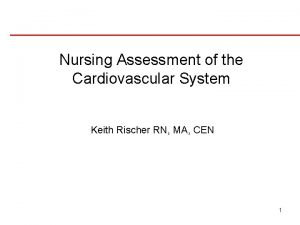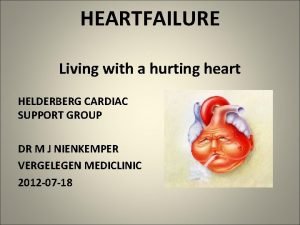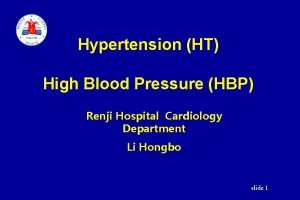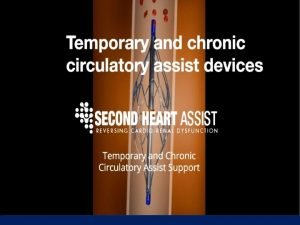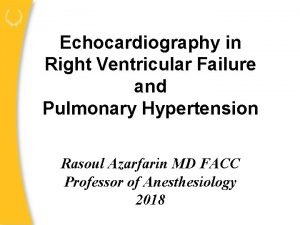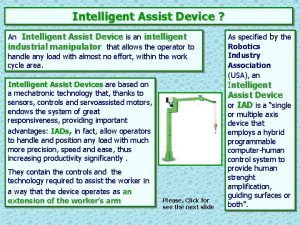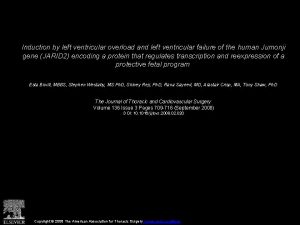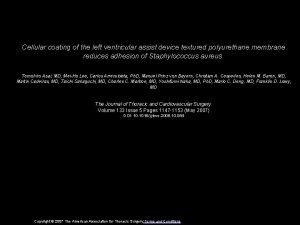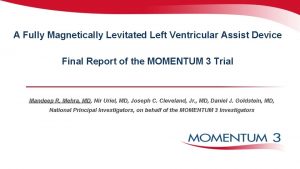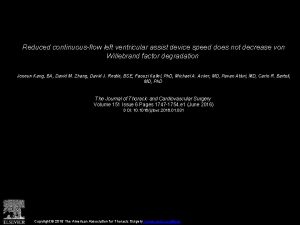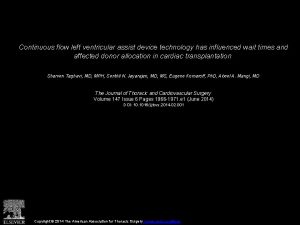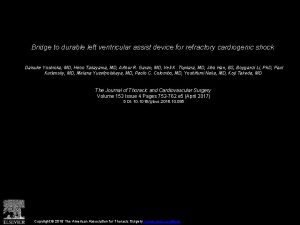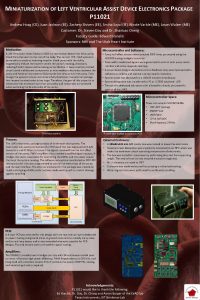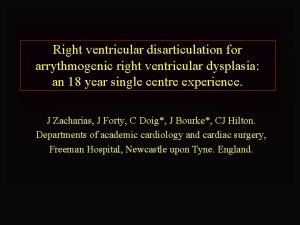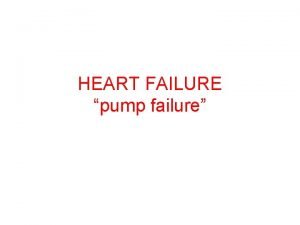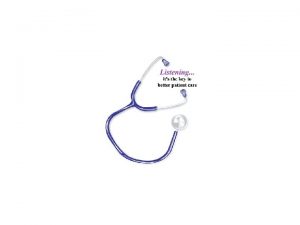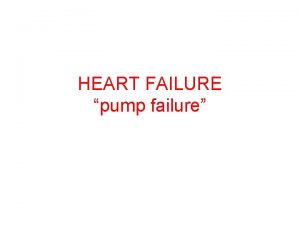Right Heart Failure in Left Ventricular Assist Device


















- Slides: 18

Right Heart Failure in Left Ventricular Assist Device Recipients Michael Kiernan, MD, MS Assistant Professor of Medicine, Tufts University School of Medicine Medical Director, Ventricular Assist Device Program, Tufts Medical Center

The problem with right heart failure following LVAD implantation 12 mo 78% • 6 % RVAD • 7% early extended inotropes Survival Total RVF 20% (N=484) • 7% late inotropes Kormos. J Thorac Cardiovasc Surg 2010; 39: 1316 59%

Identifying risk for RVF Fukamachi 1 Michigan RVFRS 2 Kormos 3 Device Type Pulsatile (84%) & cf-LVAD (16%) cf-LVAD # of LVAD patients 100 197 484 RVF Definition RVAD, inotropes, i. NO RVAD, inotropes Incidence of RVF 11% 35% 20% Incidence RVAD 11% 15% 6% Institution Single center Multicenter Predictors Univariate Multivariable RVSWI < 300 Vasopressor support Ventilator support Mean PAP < 40 Bilirubin > 2. 0 mg/d. L BUN > 39 mg/d. L AST > 80 IU/L RA/PCWP > 0. 63 Creatinine > 2. 3 mg/d. L 1. Fukamachi. Ann Thorac Surg 1999; 68: 2181. 3. Kormos. J Thorac Cardiovasc Surg 2010; 139: 1316 2. Mathews. J Am Coll Cardiol 2008; 51: 2163

Complex etiology of post-LVAD RV failure • Chronic • Intra-op ischemia RVD & IVS RVF PVR RAP Stroke Volume • PRBCs • TR • Hepatic/renal congestion • High LVAD flow Mc. Donald. Curr Opin Card. 2009; 24 Meineri. Best Pract & Res Clin Anesth 2012 (26): 217 RV • • CPB PRBCs Hypoxia Acidosis LV Pressure vessel (mm. Hg)

Severe RV Failure in INTERMACS Continuous Flow LVAD N =2900 RVAD at time of LVAD Implant N = 84 (3%) RVAD: Durable N = 5 (6%) Kiernan. ISHLT 2012 RVAD: Temporary N = 79 (94%) Return to OR for RVAD N = 26 (1%) RVAD: Durable N = 5 (20%) RVAD: Temporary N = 21 (80%)

56% Cleveland. J Heart Lung Transplant 2011; 30(8): 862

Early management: Outcomes with planned versus delayed Bi. VAD Survival until Discharge P = 0. 001 P = 0. 054 P = 0. 046 Fitzpatrick (UPenn). J Thorac Cardiovasc Surg 2009; 137(4): 971 Median time to delayed RVAD 2 days

Risk Factors for Early RVAD Following LVAD Surgery Adult Primary Continuous Flow Implants (N=2900) Multivariable Logistic Regression (Event=RVAD) Risk Factors (pre-implant) INTERMACS Patient Profile Level 1 Pa. Pi (per 1 unit larger) LVEDD (per 1 mm increase) RV dysfunction by echo (any) Primary Diagnosis CAD Hemoglobin (per 1 gm/dl increase) Concomitant surgery INTERMACS Patient Profile Level 2 Kiernan. ISHLT 2012 Odds Ratio 3. 11 0. 78 3. 17 1. 78 0. 89 1. 55 1. 81 p – value < 0. 0001 0. 0003 0. 01 0. 03

Pulmonary Artery Pulsatility Index Pa. Pi = PA Systolic Pressure – PA Diastolic Pressure Right Atrial Pressure Korabathina. Catheter Cardiovasc Interv. 2011 Sep 27.

Prevention? : Pre-op optimization Class I (LOE C) Therapy (Preload, Afterload, Inotropy): • Diuresis • Renal Replacement • Vasodilators • Inotropes • IABP/short term MCS • Vitamin K • Surgical technique • ? RCA/LAD revascularization Goals: • RA < 15 mm. Hg • Euvolemia Piazza. Chest 2005; 128: 1836 -52 ISHLT 2013 MCS Guidelines. JHLT 2013; 32: 157 -187 • Correction metabolic derangements and endorgan function

Implants June 2006 – March 2011: RHF Analysis Adult Primary Continuous Flow Implants N=2900 By Right Heart Failure Level Severe Right Heart Failure, n= 110 % Freedom RHF Moderate or Worse Right Heart Failure, n= 398 Mild or Worse Right Heart Failure, n=1284 Overall p < 0. 0001 Event: Right Heart Failure Months post implant

Readmission rate by cause following LVAD implantation Readmission rate Hospitalization/(patient*yr) 0 -6 m Hasin (Mayo). JACC 2013; 61(2): 153 7 -12 m

Impact of Tricuspid Valve Repair at time of LVAD Only N=81 LVAD + TVR N=34 P-value Baseline Characteristics 1. 78 + 0. 8 1. 98 + 0. 9 0. 32 BUN 36 + 21 48 + 30 0. 06 CVP/PCWP . 57 + 0. 2 0. 75 + 0. 3* <0. 01 CVP 16 + 8 19 + 7 0. 09 Severe TR 33% 62% OUTCOMES RVAD 10% 3% 0. 27 Inotrope 10 d (8, 17) 8 d (7, 12) 0. 04 21% 0. 05 Post-op 39% renal insuff Hosp LOS 23 d (16, 46) 19 d (14, 25) 0. 02 Piacentino (Duke). Ann Thorac Surg 2011; 92: 1414 LVAD + TVR Survival SCr LVAD

2196 patients with mod-severe TR--27% TVR associated with: • No difference in death or RVAD • Increased renal failure • Greater transfusion requirement • Increased LOS JHLT 2014

Effect of digoxin on RV function in primary pulmonary hypertension with symptomatic heart failure Class IIb (LOE C) Rich (Rush). Chest 1998; 114: 787 -792.

Effect of PDE-5 A inhibition on PVR and RV hemodynamics post LVAD d. P/dtmax/IP PVR (WU) Control Sildenafil Tedford (Hopkins). Circ Heart Fail 2008; 1: 213 Class IIb (LOE C)

RV d. P/dt max RVSP PHTN Control Effect of RV pacing on RV function in model of pulmonary hypertension induced RVD Class IIb (LOE C) Handoko. Am J Physiol Heart Circ Physiol 2009: 297: H 1752

Conclusions & Future Directions • RVF post LVAD remains common • Need multi-disciplinary pre-op evaluation • Need data/trials investigate operative techniques • Need trials investigate strategies for management of chronic RVF • Trials of temporary RV MCS support ongoing pre- and post-LVAD • Emerging biventricular mechanical support devices
 Heart sound landmarks
Heart sound landmarks Right vs left-sided heart failure chart
Right vs left-sided heart failure chart Left left right right go turn around
Left left right right go turn around Left left right right go go go
Left left right right go go go Right product right place right time right price
Right product right place right time right price Family time
Family time Pathophysiology of valvular heart disease
Pathophysiology of valvular heart disease Left ventricular hypertrophy
Left ventricular hypertrophy Heart hypertrophy
Heart hypertrophy Second heart assist
Second heart assist Rvsp
Rvsp Intelligent assist device
Intelligent assist device Trabeculae carneae
Trabeculae carneae Right and left border of heart
Right and left border of heart Ventricular escape rhythm
Ventricular escape rhythm Failure to pace
Failure to pace Example of ductile fracture
Example of ductile fracture Input device output device storage device
Input device output device storage device The right man on the right place at the right time
The right man on the right place at the right time
